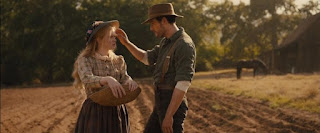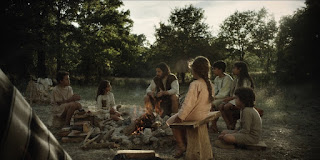Redeeming Love Review Round-up
Larger Publications
The film has been reviewed by a number of larger publications in the USA. Variety's Guy Lodge calls it "long, lumbering and ideologically retrograde" and finds it's links to the Book of Hosea "superficial". He criticises the overall tone for being "drippy", "teen" and typified by "Hallmark sunrises". Finding the repetitive plot tedious particularly excoriating the "together-then-apart dance" between it's lead characters which features "no fewer than three separate shots of a wedding ring being left on a dresser." Moreover he asks a more foundational question "Does Angel need to be 'redeemed' by love, or does she just need men to cut her a break?" and jokes that "its gender politics, at least, are authentically immersed in the 19th century."
Katie Walsh, the reviewer for the LA Times is not alone in drawing attention to the Shakespeare quote that opens the film ("All that glitters is not gold") quipping that it "doesn’t yield any cinematic riches". She is the only reviewer I've read so far to pick up one of the things I found troubling about the trailer, specifically that the film could be interpreted as making its hero Michael...
"an isolated religious zealot who believes he receives a message from God that a local sex worker is intended to be his wife, spurring him to kidnap her from the brothel while she’s in a weakened state and press her into a life of wifely duties though she attempts repeatedly to escape."
Indeed she concludes that the film "plays like 'tradwife' fan fiction" and worries about why the decision to adapt this source material was made, now of all times. Walsh's review also appears at the Chicago Tribune.
The Washington Post's Michael O'Sullivan only gives the film two stars out of four, but is perhaps the most positive I have come across. He praises director D.J. Caruso 's "slick work" and calls the film "an engrossing but superficial epic" ultimately finding it "an incident-rich saga populated by cardboard heroes and villains and outfitted with greeting-card sentiments and cartoon villainy".
Christian Critics
In terms of more specifically Christian reviewers, Peter Chattaway has, as ever, been all over this one, trailing Friday's release with one post looking at older more incidental uses of the Hosea/Gomer story and another looking at 21st century adaptations of the story including Oversold (2008), Amazing Love (2012) and Hosea (2018). Peter's review of the film itself is here and one of its main complaints is that the Hosea character (Michael Hosea) is not sufficiently developed:
But if you’re going to ditch the prophetic message that is the Book of Hosea’s point, then at the very least I’d like to see some realistic human behaviour; if you’re going to tell a story about a man who dedicates his life to a complete stranger’s sexual salvation, you have to give me some sense of who he is and why he’s doing what he does.... if I’m going to believe in a relationship, I need to believe in both partners as people. Instead, what we get feels like mere wish fulfillment.
Peter's piece also ends with a few notes similar to Peter's treatment of the other "Hosea/Gomer" films. For what it's worth I find the male character's name notable for two reasons. Firstly it just sounds bad. Michael Hosea? But also in Christian tradition Michael happens to be the name of the third original archangel after Gabriel and Lucifer (though the non-canonical Book of Enoch mentions 7). Given that the lead female character here is called Angel, the association of "The Duke" with the devil (i.e. Lucifer) and Michael's perfection this seems an unlikely coincidence. After all, the Archangel Michael is known for fighting for good over evil, defending God's people and empowering them.
Another review from a Christian perspective is that of Mike McGranaghan for Aisle Seat. Going for the jugular right away ("Redeeming Love is the most sexually-charged faith-based film I've ever seen. And, frankly, one of the most misguided.") and condemns its unenlightened and "relentlessly old-fashioned" story of "a whore who's lucky to have a good man to rescue her" as well as it's use of shocking plot points just to grab attention.
Leah MarieAnn Klett, the editor of Christian Post disagrees arguing "Redeeming Love tries hard to deal gently with tough topics, but there’s no way to sugarcoat prostitution, sex trafficking, murder and incest." Ultimately, though, Klett finds that the "film’s redemptive and biblical themes are evident, but ... overshadowed by explicit, sometimes unnecessary content" suggesting "conscientious viewers would do well to pass."
Given its usual support for Christian Movies I thought MovieGuide might be a little more in favour and it does support its "strong Christian worldview". However it ultimately summarises the film as "lackluster and unnecessarily graphic". Reviews like this make it interesting to see how the film will perform at the box office. It's clearly pushing the envelope for Christian movies/faith-based films, but it's based on existing IP - Francine Rivers’ 1991 novel which was a major hit in large part due to Christians - and it may be that this same audience likes this kind of content despite the warnings of its film critics. At the moment the audience score on Rotten Tomatoes is 95%. I don't think it's too much of a stretch to assume that the majority of those viewers will be professing Christians.
Other Web Critics
Elsewhere on the web Nell Minow's 2-star review for rogerebert.com nevertheless notes how "the novel has a lot of passionate fans who will want the movie to be exactly what they imagined on the page, and that is what they will find... [it's] a story that fits comfortably and reassuringly into a particular spiritual world view." Likewise while the film's numerous instances of sexual abuse may shock some, interestingly Minow cleverly observes how this is perhaps in keeping with "the 'Hell House'-style fascination with (and amplification of) the sins of the world". She does note some positives though especially such as its "beautiful settings" and the way that leads Abigail Cowan and Tom Lewis "make a very appealing couple, warm and natural".
If the above reviews seem bad then Anna Venarchik for The Daily Beast goes even further, even the url pulls no punches ("evangelicalisms-toxic-slut-shaming-tale-gets-the-hollywood-treatment"). Venarchik is seemingly more familiar with the Rivers' novel than many of the above reviewers which allows her to highlight things that are not explicit in the film, but nevertheless there in the subtext (for many at least, including the filmmakers) such as Michael's unintentionally hilarious description of Abigail as "a soiled dove". She ends pondering "the fates of the harlots who didn’t catch the farmer’s eye" and how the writers seem to "confirm the correlation between beauty and a woman’s prospects—the unredeemed are consumed in a hell this side of death when they perish in a fire at the brothel." It's a great review which expertly tempers its ire at the film's problematic worldview with biting wit.
========
If I can find time I might try and write some of my own thoughts about all this, albeit based on little more than the above reviews, the trailer and my knowledge of Hosea. I'm particularly intrigued by the way that Hosea and Gomer were largely absent from our screens for the first 11 decades of cinema history and have now been depicted four times in the last 15 years.
I mentioned above the film's audience score of 95% on Rotten Tomatoes. I should note that the critics score for Redeeming Love on Rotten Tomatoes is at the other extreme, 11%. IMDb currently has it as 7.3, but it's metascore is 31%. Edit: Box Office Mojo is recording an opening weekend domestic take of $3.7 million. That's slightly less than the $4.2 million that Christmas with the Chosen made but, as Peter Chattaway reports, it's still the top ranking new movie for last week and highest film that isn't a sequel.
It's hardly the first film to divide audiences from critics, but it's interesting to see that even the concerns of Christian critics are not putting off "the faithful". I'm curious to know how church leaders are framing this. Do they share the concerns of critics about the sexual content (or the depiction of women) or the apparent early enthusiasm of everyday churchgoers?
Labels: Hosea, Modernisations, Redeeming Love


















